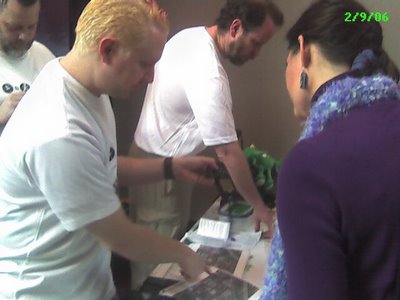Why would an Architect Care About Technology?
Over the last several days I attended the Northwest Council for Computer Education annual conference. One might ask why an Architect or Executive Director of Facilities, for a moderately sized school Distict, would want to attend such a conference. After all how does the built environment relate to the world of learning? Certainly the environment presents a physical backdrop (or venue) for learning to take place. As such the physical environment should be an enabeling space, and provide the user with a platform for maximum flexibility to solve, as yet unknown problems. It seems that this is the lowest common denominator ie. as architects we create a space which allows a myriad of functions to take place; spaces filled with: surfaces, light, sound, air, temperature, technology, etc., which in effect allow user to function physically in the effort to attain their goals.
Semiotics
There is however another result (intentional or not) of architecture. Space has meaning, just as a word, sentance, paragraph, or novel has meaning.
Meaning happens! Regardless of intention or understanding it happens.
Discursive Communication
If one writes a sentence one creates meaning. The meaning is governed by a common shared code between the sender and the receiver. The reading of the code is temporal ie. one word after the other as is language. One can guess, at, but can not know the next word, sentence, or paragraph that is forthcomming. The code itself exists in its own esoteric construct and it can be understood without context, at least with respect to "denotation" between the sender and the receiver as long as there exists a shared code.
Wer dei Sprache nicht kennt kann also die hinweisung nicht verstehen. Unless you speak German you won't understand.
Presentational Conmunication
Architecture (or space) is beyond its physical reality a form of presentational communication. What is key here is that architecture (presentational communication) is not temporal and derives meaning primarily in context, beyond the primodial understanding of structure (statics). Thus the term "regional" architecture which implies an understanding of the local or regional context in which it exists. Arguably this context is the architectural version of the discursive "code" through which the decoder derives meaning. The experience of space is not temporal rather random or wholistic. The temporal experience is not dictated by the construct (code) but rather is under the control or discreation of the individual. The senses involved transend those used in discursive communication to include: the kinesthetic experience, smell, sound, touch, sight (color), tactile etc.
I have spent a consideralbe part of my professional life as an architect to understand the differences between prensentational and discursive communication with respect to how either impart meaning. I would submit to you that architecture as a presentational medium of communicating meaning is an incredibly powerful medium, which in fact, has a far greater immediate impact on the individual than other forms of communication such as the discursive.
So Why Techonology in Education
It seems to me, as a consumer, that education has been anchored in discursive "sit and get" communication. By introducing techonology into the classroom one introduces presentational communication, which if done properly engages all the human senses; as well as all the human learning styles just as architecture does (de facto). This should serve to engage more students in broader and more understandable communication forms. The key here is "more" and "engagement". The traditional assumption that discursive communication is the primary collective medium for communication is falatious. Reaching out to all students using all modalities of communication based all learning styles is paramount if truely "No Child Will Be Left Behind".
Technology in eduction opens up all our human senses and allows all of us to learn in the way most effective for each of us. This should maximise the potential of all of our students.
The Price of Technology (Presentational Communication)
If one accepts the premis that presentational communication is, at its core contextual, and not a prescriptive, essoteric, construct, as is discursive communication, then the logical result is that it is encumbent upon all teachers (or architects) to understand the context in which this commuication is taking place, for proper encoding (design) to take place. Such an understanding of "context" is much more difficult than learning "language". It requires letting go one's own context an making serious effort to understand that of the reciever of the message. This is in a certain sense a socialist approach to meaning ie. the general populace determines the meaning not the "ivory tower".
I would submit that the battle for control of meaning is being fought in places like "WkiPedia" but that discussion is for another time. Chew on this for a while and let me know what you think.
Some further reading on the subject of semiotics:
Naom Chomsky
Susanne Langer
Juan Pablo Bonta
Just "Google" the bunch.
Ok so I can't leave you without just a small amount of political commentary.
 Create a common enemy, conduct secret wire taps, take people to secret prisons, conduct secret trials, apply secret penalties, everyone feels safe.... so what's the price?
Create a common enemy, conduct secret wire taps, take people to secret prisons, conduct secret trials, apply secret penalties, everyone feels safe.... so what's the price?What if its you??
What is the price of our collective freedom?


















